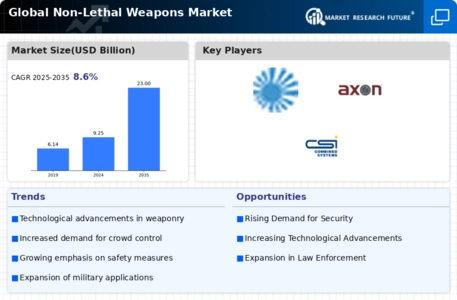Market Analysis
In-depth Analysis of Non Lethal Weapons Market Industry Landscape
The Non-Lethal Weapons (NLW) market is influenced by a multitude of factors that collectively shape its growth, adoption, and evolution. One of the primary market factors is the increasing global focus on civilian protection and law enforcement with minimized fatalities. As governments and law enforcement agencies prioritize the safety of civilians and aim to avoid lethal force when possible, the demand for non-lethal alternatives rises. NLW offer a crucial means to incapacitate or deter threats without causing permanent harm, aligning with the broader societal and regulatory emphasis on minimizing casualties.
Having shed its non-lethal past, the weapons market is now aiming for an 8.2% growth blast-off, projected to soar from a cool USD 5.65 billion in 2019 to a stellar USD 8.37 billion by 2028. This surge is fueled by evolving market trends, propelled by the desire for less-lethal options that still pack a punch in crowd control, riot suppression, and self-defense situations. Prepare for a future where these non-lethal weapons dominate the market landscape, ensuring safety with a responsible bang.Technological advancements play a pivotal role in shaping the market factors of NLW. Innovations in materials, electronics, and propulsion systems contribute to the development of more sophisticated and effective non-lethal technologies. Manufacturers invest heavily in research and development to stay ahead of technological trends, providing law enforcement, military, and security forces with cutting-edge NLW solutions. The rapid pace of technological innovation is a key factor influencing the competitive landscape and overall market dynamics of non-lethal weapons.
The geopolitical landscape and security concerns are significant factors influencing the NLW market. Nations facing various security threats, both domestically and internationally, seek versatile tools for managing conflicts and crises without resorting to lethal force. NLW provide a strategic option for addressing threats in diverse operational environments, contributing to increased procurement by defense and law enforcement agencies. The geopolitical factors, including regional tensions and global security challenges, influence the strategic importance of non-lethal solutions in national defense and security strategies.
Human rights considerations and ethical concerns are integral factors shaping the NLW market dynamics. The responsible and ethical use of force is paramount, and non-lethal alternatives offer a means to address security challenges while respecting fundamental human rights. Compliance with ethical guidelines and adherence to international human rights standards contribute to the market factors by establishing a framework for the development, trade, and deployment of NLW. The incorporation of ethical considerations into defense and law enforcement practices enhances the credibility and acceptance of non-lethal technologies.
The need for versatile NLW options for law enforcement and military applications is a significant market factor. Security forces require a range of non-lethal capabilities tailored to diverse operational environments, including riot control, crowd management, and perimeter defense. The market dynamics are influenced by the demand for NLW that can be adapted to different scenarios, providing security forces with flexible and effective tools for addressing evolving threats.
Regulatory frameworks and international agreements play a crucial role in shaping the market factors of NLW. The use of NLW is subject to legal and ethical considerations, with international conventions and agreements influencing their development, trade, and deployment. Compliance with regulatory standards ensures the responsible and lawful use of NLW, contributing to market factors such as public acceptance, government procurement decisions, and adherence to international norms.
Operational efficiency and the pursuit of cost-effective solutions are significant factors driving the NLW market. NLW technologies offer advantages in terms of minimizing the risk of lethal consequences, reducing collateral damage, and providing law enforcement and military forces with versatile tools. The demand is influenced by the recognition of NLW as valuable investments for optimizing force options, reducing the reliance on lethal force, and enhancing overall operational efficiency.
Market competition and industry collaborations are notable trends influencing the market factors of NLW. Companies in the market often engage in collaborations, partnerships, and strategic alliances to leverage collective expertise and resources. These collaborations aim to advance technology, streamline certification processes, and ensure the seamless integration of NLW into various operational contexts. The dynamics of industry collaborations contribute to a more comprehensive and effective NLW ecosystem, fostering advancements in technology and expanding the market reach of non-lethal solutions.









Leave a Comment